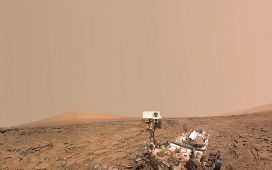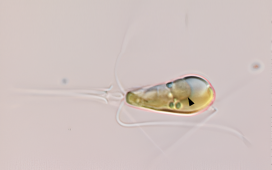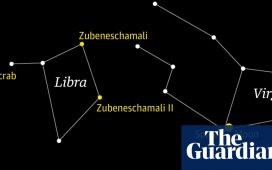
Alien life could be more common than we thought, according to scientists.
But any extraterrestrial life out in the universe is likely to inhabit a very different star system, very far away, the researchers conclude.
The new study looked at a theoretical twin of Earth and explored how it might fit in with a binary star system. Unlike our own solar system, such places have planets that revolve around two stars.
They found out that in 87 per cent of cases, those planets should be tilted similarly to Earth. That in turn is thought to be an ingredient for a climate that favours the birth of complex life, like ourselves or aliens.
Those star systems are found throughout the universe, suggesting that at least some of them could serve as home for planets where alien life looks up to see two suns in the sky. Single-star systems like the one we live in actually appear to be more rare.
1/10
The eye of Hurricane Dorian as captured by Nasa astronaut Nick Hague from onboard the International Space Station (ISS) on 3 September
Nasa/EPA
2/10
The River Nile and its delta captured at night from the ISS on 2 September
Nasa
3/10
The galaxy Messier 81, located in the northern constellation of Ursa Major, as seen by Nasa’s Spitzer Space Telescope
Nasa/JPL-Caltech
4/10
The flight path Soyuz MS-15 spacecraft is seen in this long exposure photograph as it launches from the Baikonur Cosmodrome in Kazakhstan on 25 September
Nasa/Bill Ingalls
5/10
Danielson Crater, an impact crater in the Arabia region of Mars, as captured by Nasa’s Mars Reconnaissance Orbiter spacecraft
Nasa/JPL-Caltech
6/10
A team rehearses landing and crew extraction from Boeing’s CST-100 Starliner, which will be used to carry humans to the International Space Station at the White Sands Missile Range outside Las Cruces, New Mexico
Nasa/Bill Ingalls
7/10
Bound for the International Space Station, the Soyuz MS-15 spacecraft launches from the Baikonur Cosmodrome in Kazakhstan on 25 September
Nasa/Bill Ingalls
8/10
Hurricane Dorian as seen from the ISS on 2 September
Nasa
9/10
A string of tropical cyclones streams across Earth’s northern hemisphere in this picture taken from the ISS on 4 September
Nasa
10/10
The city of New York as seen from the ISS on 11 September
Nasa
1/10
The eye of Hurricane Dorian as captured by Nasa astronaut Nick Hague from onboard the International Space Station (ISS) on 3 September
Nasa/EPA
2/10
The River Nile and its delta captured at night from the ISS on 2 September
Nasa
3/10
The galaxy Messier 81, located in the northern constellation of Ursa Major, as seen by Nasa’s Spitzer Space Telescope
Nasa/JPL-Caltech
4/10
The flight path Soyuz MS-15 spacecraft is seen in this long exposure photograph as it launches from the Baikonur Cosmodrome in Kazakhstan on 25 September
Nasa/Bill Ingalls
5/10
Danielson Crater, an impact crater in the Arabia region of Mars, as captured by Nasa’s Mars Reconnaissance Orbiter spacecraft
Nasa/JPL-Caltech
6/10
A team rehearses landing and crew extraction from Boeing’s CST-100 Starliner, which will be used to carry humans to the International Space Station at the White Sands Missile Range outside Las Cruces, New Mexico
Nasa/Bill Ingalls
7/10
Bound for the International Space Station, the Soyuz MS-15 spacecraft launches from the Baikonur Cosmodrome in Kazakhstan on 25 September
Nasa/Bill Ingalls
8/10
Hurricane Dorian as seen from the ISS on 2 September
Nasa
9/10
A string of tropical cyclones streams across Earth’s northern hemisphere in this picture taken from the ISS on 4 September
Nasa
10/10
The city of New York as seen from the ISS on 11 September
Nasa
“Multiple-star systems are common, and about 50% of stars have binary companion stars. So, this study can be applied to a large number of solar systems,” said Gongjie Li, the study’s co-investigator an assistant professor at Georgia Tech’s School of Physics, in a statement.
The researchers began by examining how the Earth’s tilt compares with Mars’ tilt. They found that our relatively mild changes in tilt help make Earth a great place for life to begin and thrive, whereas the much more extreme variations on Mars helped destroy its atmosphere.
They then looked at how the Earth might get on if it were situated in the system known as Alpha Centauri AB, which is our solar system’s next-door neighbour, and is a binary system made up of two stars known as “A” and “B”. The news was pessimistic in that system, offering bad news for those who plan to send a space probe to the system in the hope of finding alien life.
“We simulated what it would be like around other binaries with multiple variations of the stars’ masses, orbital qualities, and so on,” said Billy Quarles, the study’s principal investigator and a research scientist in Li’s lab. “The overall message was positive but not for our nearest neighbour.”
The researchers then looked further out into the universe. The findings were more positive for alien life when they looked out further, as the study showed that gentle variations like those on Earth were far more likely when looking deeper into the cosmos.
“In general, the separation between the stars is larger in binary systems, and then the second star has less of an effect on the model of Earth. The planet’s own motion dynamics dominate other influences, and obliquity usually has a smaller variation,” Li said. “So, this is quite optimistic.”
The new study, ‘Obliquity Evolution of Circumstellar Planets in Sun-like Stellar Binaries’, is published in the Astrophysical Journal today. It is was funded by Nasa’s Exobiology Program.
Social media is an increasingly important battle ground in elections – and home to many questionable claims pumped out by all sides. If social media sites won’t investigate the truth of divisive advertising, we will. Please send any political Facebook advertising you receive to digitaldemocracy@independent.co.uk, and we will catalogue and investigate it. Read more here.














